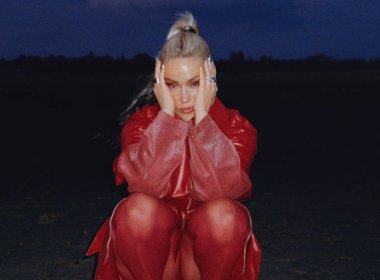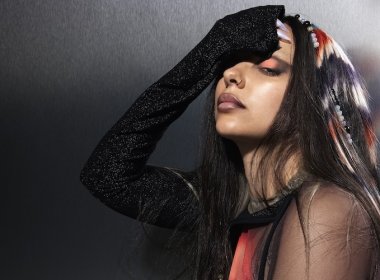
Sia wants to be heard — not seen.
That’s been happening for a while now, whether you were aware or not: As Pop’s Most In-Demand Songwriter©, Sia’s held a historic run behind-the-scenes over the past four years, responsible for penning everything from Christina Aguilera‘s “You Lost Me” to David Guetta‘s club-dominating “Titanium,” to Ne-Yo‘s “Let Me Love You” to Rihanna‘s “Diamonds,” to Celine Dion‘s “Loved Me Back To Life” to Britney‘s “Perfume” to Beyoncé‘s “Pretty Hurts” to Kylie Minogue‘s “Sexercize” to Shakira‘s “Chasing Shadows” to Jennifer Lopez‘s “Expertease.”
At some point, it seemed almost odd not to find a Sia-penned track sitting somewhere on a major label pop star’s album.
But where was Sia herself?
Fed up and overwhelmed with the constant demands of promotion, touring, photoshoots — all of the requirements of a traditional musician that don’t involve crafting music — the Aussie singer-songwriter found herself in a dangerously dark place by the time her 2010 record We Are Born was released, as documented in her New York Times profile:
Furler demanded to bring her two tiny mutts on tour, which would require renting an extra bus; she also refused to do “promo,” an obligation nearly every performer must endure, like showing up for on-air glad-handing at radio stations and submitting to numbing shifts of 15-minute phone interviews. As her addictions deepened, her behavior became increasingly dark. She eventually dressed herself and her band in masks and black costumes so crowds couldn’t see their faces onstage. In May 2010, Furler contacted a drug dealer and ordered “two of everything,” she says, except meth and heroin. She held on to her stash and contemplated taking everything at once. Months later, she was writing a suicide note.
And so, she went away for a while — at least, away from the public eye. Still hungry to create, the singer took to the recording studio and began penning songs for other artists, a move that now speaks for itself in the liner notes of nearly every major pop star’s career.
Now, with four years worth of songs building up in her back catalog, Sia finally felt the need to express herself again, but as her own artist.
And this time around, it’s happening entirely on her own terms.
To handle the promotional end of the record, Sia and her team concocted a plan to work around her “no promo” promo demand — resulting in, ironically, her most successful promo to date, starting with a paper bag placed over her head on the cover of Billboard back in October of last year.
And as for the album cover? A blonde bob, and nothing more.
“I don’t want to be famous. If Amy Winehouse was a beehive, then I guess I’m a blonde bob. I thought ‘well if that’s my brand, how can I avoid having to use my face to sell something’, so my intention was to create a blonde bob brand,” she explained to Dazed.
The blonde bob quickly became the campaign’s focal point. For the “Chandelier” video, which premiered in May, the singer enlisted 11-year-old Dance Moms starlet Maddie Ziegler for a brilliantly strange, hypnotic choreographed dance set inside an abandoned home. The mini-diva bows, jumps and twirls madly with crazed eyes and, of course, the blonde bob — a perfect representation of the song’s inner turmoil that manages to avoid heavy-handedly displaying the song’s darker undertones.
The clip went viral almost instantly, and has since skyrocketed to over 53 million views (and rising); easily her most iconic video to date.
From the wild success of “Chandelier,” the entire campaign was sprung — from recreating the video live on The Ellen Show (with Sia standing with her back to the audience against a wall, Blair Witch style), to Girls darling Lena Dunham filling in as Maddie for an insane rendition on Late Night With Seth Meyers (much to the outcry of the Internet), to an entirely blonde-bobbed NYC’s Gay Men’s Chorus on LOGO’s Trailblazers, to a Seuss-like fantasy land recreation with Maddie and dancers on Jimmy Kimmel Live.
All that major mainstream promotion — for the girl who refused to promote.
1000 Forms Of Fear is a cathartic experience, full of raw emotion and explosive energy. While the blueprint of Top 40 smashes are unmistakably embedded in the DNA of these songs — the soaring “Fire Meet Gasoline” is nothing sort of a Beyoncé-sized smash of a power ballad, for instance — this is undeniably still the work of the quirky, complicated songwriter we met way before The Fame kicked in, back when she was still the girl we lost to cocaine on Some People Have Real Problems and, of course, the vulnerable songstress behind Colour The Small One‘s “Breathe Me.”
Teaming up with constant collaborators including producer Greg Kurstin and songwriters Chris Braide, Sam Dixon and Jesse Shatkin, Sia’s gone for a more epic, embattled sound than ever before — thunderous choruses and soaring production, filled with bloody and battered lyricism. “Burn The Pages.” “Straight For The Knife.” “Fire Meet Gasoline.” Everything is sharp, hot, painful and (ultra) violent — 1000 Forms Of Fear, indeed.
The record opens with what is now her biggest solo hit of all time: “Chandelier,” an utterly explosive record that expertly marries Top 40 radio-friendly pop with a slow, painful unraveling at the hands of substance abuse. I dubbed the song the greatest pop single of 2014 in April, which I still stand by today.
Elsewhere, the singer endures mega-bouts of loneliness, as with her devastating “Big Girls Cry”. The depression is palpable, and way too real: “I’m at home on my own/Check my phone, nothing though/Act busy, order in, Pay TV…it’s agony,” she aches. This is a woman unafraid to embrace her emotions. Sorry, Fergie.
1000 Forms Of Fear is about acknowledging those fears — loneliness, fame, drug abuse, fire, needles, knives and everything else — and the music often matches the message, as with her Hunger Games theme “Elastic Heart,” penned alongside Diplo. The anguished battle cry plays like a worn and wounded sequel to “Titanium,” as the singer successfully limps her way through Diplo’s tripping drum loops and gunshots. Similarly, the slow-marching “Eye Of The Needle” sees Sia soldiering on: “Step and repeat/Tears fall to the beat/Smile through pain, feel the acid rain,” she sorrowfully sings.
It’s not all devastation, though — promise! Actually, there’s plenty of hope hidden underneath all the heartbreak and gasoline. “Yesterday is gone and you will be OK/Place your past into a book, burn the pages, let ‘em cook,” she assures on the buoyant, hi-hat heavy “Burn The Pages,” a soaring moment of encouragement that feels like a therapeutic moment of self-assurance in the face of a heavy past. “So don’t worry, don’t worry, I’m here by your side,” she repeats.
“Hostage,” crafted along The Strokes‘ Nick Valensi (who played guitar on We Are Born), plays like a refreshingly uptempo continuation of her 2010 record, full of fiery electric guitar riffs and even some playful xylophone. (Sia loves herself some silly sounds when she’s not bawling her eyes out.) “It all begins with just one kiss/I’m held hostage by your love/Put me in cuffs, lock me up/I’m held hostage by your touch!” she wildly yelps. Like Lana, Sia prefers her love to come with a bit of force.
Speaking of Lana, Sia teams up with the man who started it all for the Born To Die beauty, “Video Games” co-writer Justin Parker, on the appropriately theatrical “Straight For The Knife,” which carries subtle shades of the cinematic sound that Lady Lana holds dear. But unlike Lana, Sia’s not head-over-heels in love — she’s running right for the door: “You went straight for the knife and I prepared to die/Your blade it shines/Looked me straight in the eye, you turned the gas on high,” she sings. “You wonder why I’m scared of fire.” Hear that? There’s the fear right there.
And then, there’s “Fire Meet Gasoline,” which was co-penned with longtime collaborator Sam Dixon, and arguably the most Top 40 friendly moment on the record, aside from “Chandelier.” The sweeping track plays like an arena-sized companion to Beyoncé’s “Halo” — just more violent. And much more flammable. “I can barely breathe when you’re here loving me/Fire meet gasoline!” she soulfully bellows, evidently succumbing to her pyrophobia in the face of love.
If Sia is anything, it’s self-aware: “Look at me, I’m such a basket case/Delivered to you wrapped in cellophane,” she speak-sings across crisp vinyl crinkles and a dull throb on “Cellophane,” recalling that of Fiona Apple‘s poetic and tortured mind. “Patience is your virtue, saint o’ mine/I’d have fallen through the cracks without your love tonight.”
The album’s greatest highlight, though, singles aside, is “Free The Animal,” a carnal, murderous blend of death and a very deep love. You know that feeling when you see a tiny hamster or a teacup piglet, and it’s just so cute and tiny that you just want to squeeze it to death? It’s sort of like that with Sia and her beau.
“I love you so, wanna throw you from the roof,” she happily confesses on the sultry, searing record, which seamlessly blurs the lines between electronica, rock and pop. “I’ll squeeze you tight until you take your last breath/Loving you to death, loving you to death!” But it’s that humungous chorus, with the yelps (“Detonaaaaaaate me!“) and shouts (“Shoot me like a cannonball!“), that completely seals the deal.: It’s almost like a cross between Garbage and the Yeah Yeah Yeahs, or something like that — a completely unhinged, major moment of letting go for the powerhouse vocalist.
The autobiographical “Dressed In Black” brings the album to a close; a nearly 7-minute ode that contains perhaps one of the best lines of the whole record: “You do for the wounded what they couldn’t seem to, you set them free/Like a butterfly kissing a child with an eye for the minor key.” (So amazing, and so very Sia.) As the song comes to an end, Sia simply, soulfully harmonizes with herself against endless waves of drums and twinkling electronica — no lyrics, no flashy distractions — just the music.
Like the Queen of Pop herself, Madonna, Sia is a pop star who simply doesn’t play by the pop rulebook — because she doesn’t have to: She is one of the most talented, prolific songwriters of this generation.
With a bonafide hit now climbing on Top 40 radio and more songwriting credits to her name than some of the most frequently employed pop producers and songwriters, she’s challenging the very concept of what it actually means to be a pop star in 2014. (It’s just a shame that Mariah Carey already declared that incredible title for herself — because if anyone is an Elusive Chanteuse around here, it’s Sia.)
And while some fans might lament the fact that Sia’s not more visible in the mainstream, they’re sort of missing the point: She doesn’t want the fame. She doesn’t want that pressure. She will immediately exit stage left.
Instead, Sia’s very much blazing her own trail and belting to the beat of her own drum. And, when she wishes to exorcise the demons, she will. That’s 1000 Forms Of Fear, a release that feels like exactly that: A release.





‘1000 Forms Of Fear’ was released on July 8. (iTunes)




